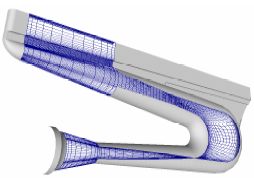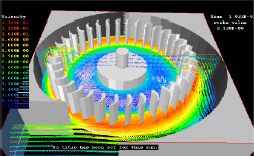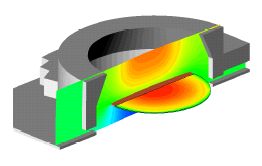PHOENICSby Cham
PHOENICS is a general-purpose software package which predicts quantitatively how fluids (air, water, steam, oil, blood, etc) flow in and around engines, process equipment, buildings, human beings, lakes, river and oceans, and so on.
PHOENICS is a powerful multi-purpose Computational Fluid Dynamics (CFD) software package. PHOENICS provides an accurate, reliable, cost-effective, and easy-to-use tool to simulate a range of processes involving fluid flow, heat or mass transfer, chemical reaction and/or combustion in engineering equipment and the environment.
With the longest history of validation and a large user base, it is not surprising that PHOENICS has a proven track record in nearly every branch of science and engineering in which fluid flow plays a key role. Many organisations large and small are using PHOENICS to sharpen their competitive edge in the research and development of products and processes involving fluid flow and heat transfer.
 PHOENICS offers: PHOENICS offers:
- True Ease of Use
PHOENICS uses an intuitive 3D interactive user environment for pre- and post- processing.
- Proven Performance
PHOENICS boasts an impressive portfolio of applications.
- Unique Array of modelling features
Multi-phase flows, particle tracking, free-surface modelling; chemical reaction, moving grids, fine-grid embedding - part of an extensive battery of modelling features offered by PHOENICS.
- Expandability
User-defined inputs made easy via built-in features such as "GROUND" & "IN-FORM"
- Licensing flexibility
PHOENICS provides flexible and cost-effective solutions, from PC to mainframe, short-term to perpetual, whether individual student or multi-national corporation.
Technical Outline
Easy-to-Use Graphical User Interface
The PHOENICS Virtual Reality interface incorporates the VR-Editor and VR-Viewer, a 3D interactive graphics system for visualisation of geometry, solution control and results data.
- CAD files are imported readily into the VR-Editor for problem definition.
- Built-in, interactive grid-generation.
- BFC grids generated by third party packages can be imported into PHOENICS.
- VR Viewer post-processor with plots of mesh, velocity vectors, contours, streamlines, iso-surfaces, plotter / printer output, animation and slide show facilities.
 Tutorial and Library examples, with over 1000 simulation examples and test cases. Tutorial and Library examples, with over 1000 simulation examples and test cases.
Facet-Fixer - an integrated utility which examines and repairs possibly-defective STL files produced by CAD packages, and creates data files suitable for use with the PHOENICS Virtual-Reality User Interface.
IN-FORM facilitates the addition of new physical and numerical features, the input of problem-defining, solution-controlling and results-presentation data using the VR interface.
PARSOL - the partial solid treatment developed in the PHOENICS solver, improves the accuracy of flow simulations for situations in which a fluid/solid boundary obliquely intersects some of the cells of a Cartesian or polar coordinate grid.
MOFOR, the moving-body simulation, permits the simulation of flows induced by bodies in motion, important both in the mechanical industry and in human motion.
Modelling Capabilities
- Problem dimensionality: one, two and three dimensions.
- Time dependence: steady state and transient processes.
- Grid systems: Cartesian, cylindrical-polar and curvilinear co-ordinates; rotating co-ordinate systems; multi-block grids and fine grid embedding.
- Compressible / incompressible flows.
- Newtonian / non-Newtonian flows.
- Subsonic, transonic and supersonic flows.
- Flow in porous media, with direction-dependent resistances.
- Convection, conduction and radiation; conjugate heat transfer, with a library of solid materials and automatic linkage at the solid fluid interface.
- A wide range of built-in turbulence models for high and low-Reynolds number flows; LVEL model for turbulence in congested domains and a variety of K-E models, including RNG, two-scale and two-layer models.
- Multi-phase flows of three kinds with a variety of built-in interphase transfer models:
- Inter-penetrating continua, including turbulence and modulation
- Particle tracking, including turbulence dispersion effects
- Free-surface flows
- Finite-volume approach on staggered or collocated grids, with 13 choices of discretisation schemes for convection.
- Combustion and NOx models, with a range of diffusion and kinetically controlled models including the unique Multi-Fluid Model for turbulent chemical reaction.
- Chemical kinetics including multi-component diffusion and variable properties. Built-in interface to the CHEMKIN chemical database.
- Advanced radiation models, including surface-surface model with calculated view factors, a six-flux model and composite radiosity model for radiative heat transfer, known as IMMERSOL.
- Mechanical and thermal stresses in immersed solids that can be computed at the same time as the fluid flow and heat transfer.
 Alternative Solvers Alternative Solvers
- Marching-integration solver for parabolic flows such as boundary layers, jets, long ducts.
- General Collocated Variant (GCV) solver for body-fitted co-ordinates.
- Multi-grid solver, MIGAL, greatly reduces computing time.
Special-Purpose Versions
Application-specific special-purpose variants have been created to aid several industries. These are supplied as an add-on "SPP" modules to the standard PHOENICS GUI.
- HOTBOX provides an integrated "Virtual Reality" environment for electronics cooling applications.
- ESTER, electrolytic smelters.
- Heating, ventilating and smoke-movement in buildings using FLAIR.
- CVD, chemical-vapour deposition.
- ROSA for oil spills in rivers and coastal waters.
- Furnace simulation via COFFUS.
Proven Performance & Versatility
PHOENICS predictions have been subjected to many validation tests, which have proved its accuracy against measured data for a wide range of industrial applications. PHOENICS boasts an impressive portfolio of applications, from heating and ventilation to metal casting, and from mould filling to condenser analysis.
Applications
 PHOENICS offers unrivalled benefits by way of product optimisation at early stages of the design process, facilitating shorter development cycles, cost reductions, and environmental impact assessment for many industries, including: PHOENICS offers unrivalled benefits by way of product optimisation at early stages of the design process, facilitating shorter development cycles, cost reductions, and environmental impact assessment for many industries, including:
- Aerospace
- Automotive
- Building services / HVAC
- Chemical
- Combustion
- Electronics cooling
- Environment
- Fire/Smoke Hazard / Risk Analysis
- Marine & offshore / petroleum
- Medical / Health
- Metallurgical
- Nuclear and power generation
- Process
- Turbomachinery
Hardware paltforms and operating systems
DOS, Windows, Linux for PC systems; plus commonly available UNIX, mainframe and super-computer systems.
Parallel PHOENICS
Parallel PHOENICS is available on multi-processor machines as well as on cluster of single-processor ones. MPI / PVM is available for parallel machines.
|

